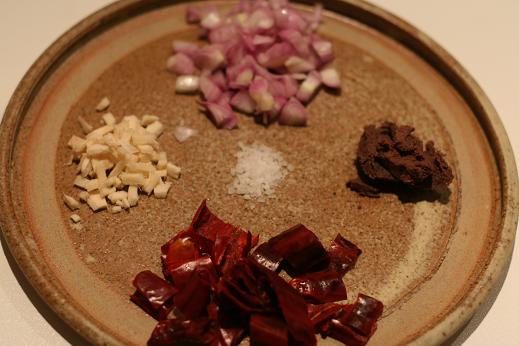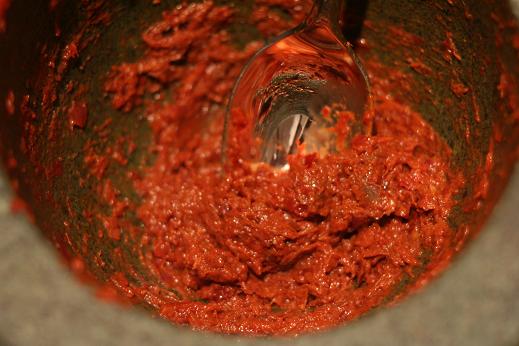Posted By Stephen
While on holiday last week, I ended up reading a lot of what I call the Big Pink Thai Book by David Thompson. We’ve had the book for a while but I hadn’t read that much of it in the past, which is why I took it on holiday with the intention of reading it.
The book covers the culture and the various regions of Thailand as an introduction to the food itself. It also gives a history of the development of Thai food and how it changes depending on the ingredients that were available in the different regions. I found all of this very interesting indeed and planned to set out on a mission to cook various Thai dishes that we hadn’t cooked before, cooking a new dish every week. Monday is a good day because if there are pastes to make then we can make them on the weekend.
So for the first edition tonight, we tried Sour Orange Curry of Trout and Vegetables. This is a fairly simple boiled curry from the Central Plains region. It was quite a change from the Thai food that we usually cook in that it didn’t contain coconut milk, lemongrass or lime. Coconut is actually quite common in the Central Plains along with the South, but less so in the North and North East.
The finished dish looked like this:

Not great presentation, but we were hungry!
To make the paste, we started off with:

5 long dried red chillis, deseeded, soaked in salted water and drained; 1 tablespoon chopped galangal, 3 tablespoons chopped red shallot, 2 tablespoons shrimp paste and a large pinch of salt. These were pounded into a paste, starting with the chillis and galangal and salt, then when they were smooth, adding the shallots and finally the shrimp paste. Which gave a paste looking like this:

The recipe said to use 100g of trout (or other freshwater fish) but we used about double that. We poached a quarter of the fish in three cups of fish stock (apparently Thai people rarely use fish stock and would probably have used chicken stock, but we used fish stock) and then broke it up and mixed it into the curry paste. This will act as a thickening agent when the paste is added to the curry.
To the stock, we added three tablespoons of tamarind water (tamarind pulp soaked and dissolved in water), a pinch of sugar and two tablespoons of fish sauce. Then we added the curry paste and simmered for a few minutes before adding a few yard-long beans, cut into sensible lengths. When these were almost cooked, we added some kale and then a minute or so later, the rest of the trout, cut into pieces. A couple of minutes later and it was done.
It tasted, as the book said it should, salty (from the fish sauce), sour (from the tamarind) and hot (from the chillis) in that order. I had expected it to taste a bit hotter than it did and thought that maybe our dried chillis were a bit old, but afterwards my lips were definitely tingling so the heat was certainly there, just in the background amongst the other flavours. Overall, it was rather good, which I was pleased about because I’d been a bit apprehensive about the fact that it contained no coconut milk and no lemongrass, which are the Thai ingredients that we both like most. Also, being a “boiled curry” rather than a “fried curry”, there is no frying of the curry paste in the beginning, which is the most exciting part.
The book gave a list of recommended accompaniments, but we were boring and just had it with rice. In a formal Thai meal, there should be various different styles of dishes served together and something like this would have been accompanied with a relish, a soup, some vegetables and probably some grilled or fried meat or fish in addition to the rice.
When making green curry as we have done on many occasions, the recipe that we use calls for some shrimp paste which we usually leave out. But having used it successfully here, I think we’ll put it in next time to give a bit more body; I usually find myself adding a bit more fish sauce than the recipe states anyway.
I’m not sure what we’ll be trying next Monday yet, we’ll have to wait and see.
6 Comments to 'Thai Odyssey Part 1 – Sour Orange Curry of Trout and Vegetables'
Subscribe to comments with RSS or TrackBack to 'Thai Odyssey Part 1 – Sour Orange Curry of Trout and Vegetables'.
:: Trackbacks/Pingbacks ::
No Trackbacks/Pingbacks
Leave a Reply
You must be logged in to post a comment.

PS They couldn’t fillet the trout in Waitrose for me because of Health and Safety reasons. Apparently the trout that they get in that are already gutted are quite slippery and people have hurt themselves filleting them. Very strange 😯
!!! You took the big pink book on holiday! That must have taken up most of your luggage allowance!
Hehe Su-Lin yes if we had been flying I think it would probably have been prohibitively heavy but luckily we were on the train from London to Edinburgh 🙂
Shrimp paste is one of my favourite ingredients – it stinks to high heaven, and often makes housemates complain, but it takes me right back to the food stalls in Bangkok. If you like kangkong (aka water spinach, or morning glory) then it is great stir-fried with garlic, ginger and shrimp paste – just a pea sized amount, mind!
I have heard that David Thompson’s book is somewhat over-elaborate – the person who said that said the Chiang Mai curry was awful. it will be interesting to see how this pans out.
Love the new layout / colours of the blog.
Wow – what an interesting sounding curry. I really enjoy fish curries, but hardly ever make them. I think that is hysterical about not filleting the fish in Waitrose! Why bother to have a fish counter if they won’t even fillet the fish for you?!
L, yes it does rather stink but it tastes really good. The green curry recipe that we usually use says to put some in a foil parcel and cook it in a frying pan for a while before mixing into the paste and we generally leave it out because it’s a bit of a pain to do all of that. We’ll probably use it next time but without doing the foil parcel thing.
Some of the recipes in the book are over-elaborate. Many of them are taken from recipe books of cooks from royal palaces, who I imagine had time and staff to be elaborate. We cooked geng gari gai from the book recently and there was a lot in the recipe about cooking the ingredients separately to make sure that too much starch from the potatoes didn’t get into the curry, etc. We didn’t bother with any of that and it all turned out well in the end anyway.
Antonia, yes I found it rather bemusing. Needless to say, I managed to fillet it (badly) at home without injuring myself 🙂